Building regulations - energy standards and associated topics - proposed changes: consultation
Consultation on proposed changes to energy standards within Scottish building regulations, including related topics such as ventilation, overheating and electric vehicle charging provision.
Part 7 – Electric Vehicle Charging Infrastructure
7.1 Introduction
The Scottish Government is committed to the decarbonisation of transport and with demand for Electric Vehicles (EVs) expected to grow rapidly, enabling people to switch to zero emission vehicles, will require ready access to convenient and reliable EV charging infrastructure.
This part of the consultation is seeking views on our preferred policy options relating to the installation of EV charge points and enabling infrastructure (namely accessible trunking, conduits or cable trays for electricity cabling) to facilitate the future installation of EV charge points in the car parks of residential and non-residential buildings.
7.2 Policy and strategic context
The transport sector is the largest emitter of greenhouse gases in Scotland, accounting for 29% of all emissions in 2019[37]. Road transport accounted for 66% of overall transport greenhouse gas emissions in that period, with cars accounting for 38% of that total.
The Scottish Government’s Climate Change Plan update (CCPu), published last December, set out the pathway to meet Scotland’s statutory greenhouse gas emission reduction targets by 2032[38]. This includes an aim to phase out the need for new petrol and diesel cars and vans by 2030.
Both the CCPu and the National Transport Strategy 2 recognise that, whilst there is an ambition to significantly reduce car demand through support for public transport and active travel, supporting the uptake of EVs will play an important part in addressing the climate emergency[39]. In addition, EVs will improve air quality in our towns and cities and play a key role as part of a sustainable transport system. Therefore, our aim is to ensure a transformative shift to sustainable, zero emission mobility in Scotland that delivers three outcomes:
- People and places benefit fairly from the shift to sustainable, zero emission mobility.
- Scotland at the forefront of markets for zero emission mobility.
- Scotland as a global destination for innovation and investment in sustainable, zero emission mobility.
To incentivise early-stage uptake of EVs, we have invested over £45 million in ChargePlace Scotland, Scotland’s largest public EV charging network, which now has more than 1800 publicly available charge points throughout Scotland. This investment means that there are more rapid EV charge points per 100,000 in Scotland than anywhere else in the UK (and in overall charge points Scotland is second only to London)[40].
We have also made available over £85 million through the Low Carbon Transport Loan to help consumers and businesses meet the upfront cost of purchasing an EV and, in 2020, this was extended to the second hand market. In addition, funding has also been provided to almost 10,000 households and businesses seeking to install charging infrastructure at home or work premises.
We are focused upon ensuring that all consumers and businesses benefit from affordable, reliable and accessible charging infrastructure in Scotland. Through our Strategic Partnership with the electricity Distribution Network Operators (DNOs), for example, we have evidenced the benefits and efficiencies of a coordinated approach to the planning and delivery of electricity infrastructure to enable EV charging[41].
In addition, our work with Scottish Futures Trust aims to create the conditions to enable more private sector financing and delivery of Scotland’s public EV charging infrastructure. Therefore, whilst the focus of this consultation is on the EV infrastructure requirements for car parks of buildings, it complements a wider body of work that is seeking to meet the future demand for EV charging.
We recognise that we cannot treat the electrification of the transport system in isolation. The CCPu also sets out how we are committed to developing regulations requiring new homes from 2024 to use zero direct emissions heating systems – with similar requirements for new non-domestic buildings to be phased in from 2024 – through a New Build Heat Standard. While it is envisaged that the Standard will be technology neutral, there is a strong likelihood that the electrification of heat will increase substantially through the use of technologies such as heat pumps in new developments. The combination of electrification of heat and EV charging has the potential to place additional demands on the electricity requirements of buildings and on local electricity networks.
We continue to work with the DNOs, Transmission Operators and Ofgem to ensure that the electricity system is ready to meet this additional demand and that required investments align with our pathway to Net Zero.
7.3 Scotland’s progress in uptake of EVs
Data from the Department for Transport (set out in the graphic below) demonstrates that Scotland is experiencing a growth in uptake of Ultra Low Emission Vehicles (ULEVs) that has risen steeply over the last few years[42]. The number of new registrations of ULEVs rose to 10,990 in 2020, representing an almost 117% increase in numbers compared to 2019[43].
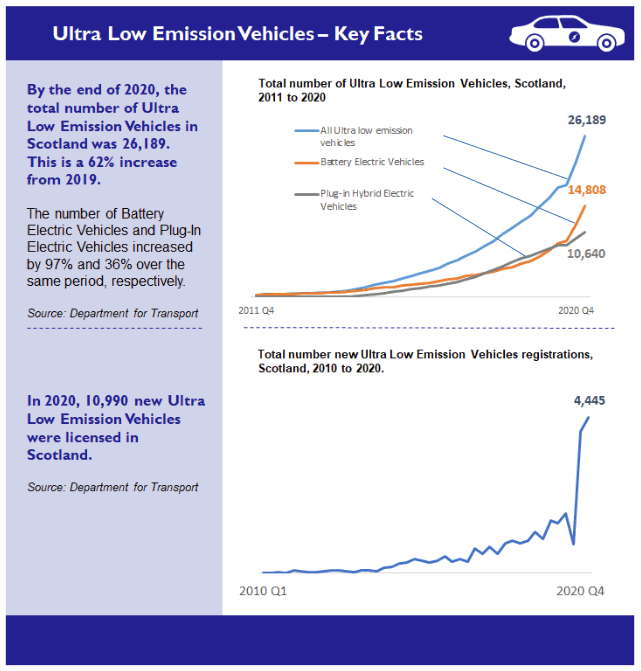
Over the next 5 to 10 years, we will see technology advances (particularly in battery efficiency and range) and the likely corresponding reductions in battery costs will rapidly drive increased ownership of ULEVs. In addition, major investment by the automotive sector to bring a wide choice of EVs to market (with a number of manufacturers committed to producing only fully electric new vehicles by 2030), alongside both our and the UK Government’s 2030 ‘ban’ on the sale of new petrol and diesel vehicles, will also be significant drivers to this change. Therefore, this expected rapid growth must be matched with corresponding growth in the availability of comprehensive and convenient EV charging infrastructure.
7.4 EV charging infrastructure – meeting future demand
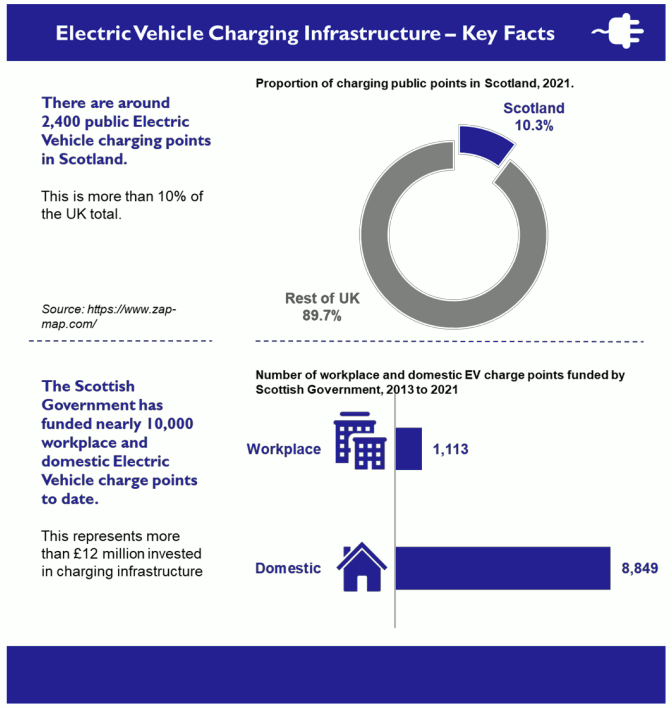
7.4.1 Introduction
Availability and convenience of EV charging infrastructure is frequently cited as an negative factor impacting an individual’s decision to purchase an EV[44]. To overcome this barrier, growth in EV uptake will need to be matched with growth in reliable and convenient charging infrastructure that puts consumer needs first. Overnight charging of an EV at home, for example, provides a convenient opportunity for many households. Similarly, opportunities to charge at other locations, including at workplace and leisure destinations, will be important for those without a dedicated driveway and to meet charging needs on longer journeys.
7.4.2 Public EV charging infrastructure
Scotland currently benefits from having around 43 publicly available EV charge points per 100,000 population and there are more rapid EV charge points per 100,000 in Scotland than anywhere else in the UK (and in overall charge points Scotland is second only to London)[45]. This is reflective of our commitment to invest in EV charging infrastructure ahead of need, in order to support and encourage uptake.
It is challenging to make an accurate assessment of the amount of charging infrastructure that will be required in the future as this will be subject to a number of variables, including advancement in battery and charging technologies. The Committee on Climate Change has estimated that there will need to be an overall investment of £280 million in Scotland (up to 2030) in public EV charging infrastructure, in addition to investment in EV charge points in homes and at workplaces[46]. Therefore, there is still much to do to ensure that Scotland will meet the future demands of a mass EV market, and the legislative measures that we are proposing in this consultation are important to our overall approach to addressing this.
7.4.3 Households with off-street parking – a proxy for EV charging opportunities
Data from the Scottish House Condition Survey indicates that approximately 56% of dwellings (i.e. a unit of occupied residential accommodation) in Scotland have access to dedicated parking other than on-street (Figure 3)[47]. This varies across Scotland with availability much lower in urban areas (e.g. Glasgow at 34%) than in some rural areas (e.g. Orkney Islands at 80%). There is therefore a significant proportion of Scotland’s population that do not have access to off-street parking at home, and will therefore have to rely upon accessing an EV charge point at their workplace and/or at other public, semi-public or private locations.
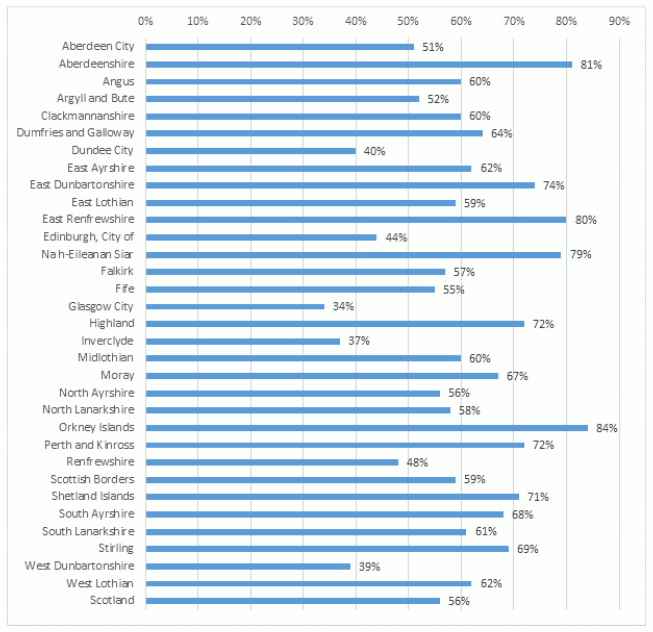
7.5 Requirements for EV charging infrastructure in car parks of buildings
7.5.1 Introduction
Deployment of EV charge points, including the infrastructure to facilitate their ease of installation at a future date, in car parks of buildings presents a significant opportunity to support the transition towards a mass market of EVs over the next decade.
If requirements for installing EV charge points and ducting infrastructure (namely accessible trunking, conduits or cable trays) are targeted at car parks of buildings when they are built, or when major renovations are taking place, then there will almost certainly be significant cost (and convenience) benefits compared to retrofit options. Whilst installing infrastructure will come at a cost, it also has the potential to deliver significant economic benefits across Scotland’s supply chains.
For requirements relating to new buildings or buildings undergoing major renovation, the intention is to introduce legislative provisions through the Building (Scotland) Regulations 2004. In addition, we plan to introduce requirements in the car parks of certain non-residential buildings where no construction work is planned through powers available in the UK Withdrawal from the EU (Continuity) (Scotland) Act 2021.
7.5.2 Directive 2018/844 and keeping pace with the EU
In July 2018, the revised EU Energy Performance of Buildings Directive (EU directive 2018/844) came into force. This amended EU Directive 2010/31 requires member states to transpose new obligations in relation to the energy performance of buildings into national law, recognising the crucial role of the building sector in meeting environmental goals.
Whilst the UK has formally left the EU, Scottish Ministers have stated that it is in Scotland’s national interests to align with the EU’s approach to legislation and policy. Our approach to the options that we are consulting upon is therefore framed within the context of EU Directive 2010/31, as amended by EU Directive 2018/844. This Directive sets out a number of requirements for the installation of EV charge points and ducting infrastructure in residential and non-residential buildings (Table 11).
| Scope | Category | Requirement |
|---|---|---|
| New buildings and buildings undergoing major renovation | Non-residential buildings[48] with more than 10 parking spaces | Ensure the installation of at least 1 recharging point Ensure the installation of ducting infrastructure for at least 1 in 5 parking spaces |
| Residential buildings with more than 10 parking spaces | Ensure the installation of ducting infrastructure for every parking space | |
| Existing buildings | Non-residential all buildings with more than 20 parking spaces | Lay down requirements for the installation of a minimum number of recharging points - applicable from 2025 |
7.5.3 Preferred options and scope of coverage
A summary of the Scottish Government’s preferred options are provided in Table 12 below. A further explanation of how these would be applied is provided in Section 7.9.
Table 12: Summary of Scottish Government preferred options for EV charge points and enabling infrastructure in buildings.
New residential buildings
All dwellings with a parking space to have at least one EV charge point socket with minimum 7kW output power rating.
Exemption to requirement to install EV charge point if additional cost of electricity grid connection exceeds £2,000.
If exemption applies ducting infrastructure to be installed in each car parking space.
Residential buildings undergoing major renovation
For buildings with more than 10 car parking spaces, ducting to be installed in each residential car parking space to support the future installation of an EV charge point.
EV charge points sockets to be installed, with minimum 7kW output power rating, in as many residential car parking spaces as the electrical capacity of the building post-renovation allows.
Exemption applies if the cost of installing recharging and ducting infrastructure exceeds 7% of total major renovation cost.
New non-residential buildings
For buildings with more than 10 non-residential car parking spaces, 1 in every 2 non-residential parking spaces to have ducting installed and 1 in every 10 non-residential parking spaces to provide an EV charge point socket with minimum 7kW output power rating.
Non-residential buildings undergoing major renovation
For buildings with more than 10 non-residential car parking spaces, 1 in every 2 non-residential parking spaces to have ducting installed and 1 in every 10 non-residential parking spaces to provide an EV charge point socket with minimum 7kW output power rating.
Exemption applies if the cost of installing recharging and ducting infrastructure exceeds 7% of total major renovation cost.
Existing non-residential buildings
By 1 January 2025, for buildings with more than 20 non-residential car parking spaces, 1 in every 2 non-residential parking space to have ducting installed and 1 in every 10 non-residential parking space to provide an EV charge point socket with minimum 7kW output power rating.
For both residential and non-residential buildings we are seeking to apply requirements where:
- The car park is located inside the building and, for major renovations, renovation measures include the car park or the electrical infrastructure of the building; or
- The car park is physically adjacent to the building, on land under the same ownership and, for major renovations, renovation measures include the car park or the electrical infrastructure of the car park.
Application within the scope of Scottish building regulations
The requirements for new buildings, and those undergoing major renovation, will apply to all car parking spaces associated with buildings to which the Building (Scotland) Regulations 2004 apply. There are some limited building types that are exempt from the building regulations, such as a building where explosives are manufactured or stored. Those exemptions, defined in regulation 3 and schedule 1 of the building regulations, will be out of scope of the new requirements[49].
As outlined above, the requirements for EV charge points and/or enabling infrastructure will also apply where an existing building undergoes a major renovation. The introduction of this as a ‘defined term’ within building regulations, (following the definitions previously set out in the Energy Performance of Buildings Directive[50]) is proposed in section 3.2.1 of this consultation under question 20.
Scottish building regulations apply a term - ‘conversion’ - to a specified range of actions which change the way in which a building is used or categorised, and which triggers the application of current standards to the building as a consequence of the proposed change. We propose that the conversion of a building, as defined by regulation 4 and schedule 2 of building regulations would trigger the application of EV provisions, subject to the same conditions in respect of the extent of works as a major renovation.[51]
7.5.4 EV charge point minimum standard
EV charging can happen at different speeds depending upon the type of vehicle, usage pattern of the location and the type of charge point. Table 13 summarises key charging types, where they are normally found and an indicative charging time, and Table 14 provides a further description of charge point definitions.
| Charge point Power | Current | Connector | Mode | Typical location | Example charging time |
|---|---|---|---|---|---|
| 3.6kW | AC | Type 1/ Type 2 | Mode 3 | Homes, on-street locations, destinations | c. 11 hours |
| 7kW | AC | Type 1/ Type 2 | Mode 3 | Homes, on-street locations, destinations | c. 5 - 7 hours |
| 22kW | AC | Type 1/ Type 2 | Mode 3 | Destinations | c. 2 hours |
| 50kW | DC | CCS/ CHAdeMO | Mode 4 | Motorway Services Areas / destinations | < 1 hour |
| 150kW+ | DC | CCS/ CHAdeMO | Mode 4 | Motorway Services Areas / destinations | < 30 minutes |
Table 14. EV charge point definitions
EV charge point definitions
Current: Charging can be AC, where alternating current (AC) is supplied to the vehicle and vehicle converts the current to direct current (DC) to charge the battery. Or the charging current can be DC, where the alternating current is converted to DC within the charge point before it is supplied to the vehicle.
Connector: The type of connector varies from vehicle to vehicle and charge point type also depends on whether they are for low (AC) or high (DC) power use. The CHAdeMO and CCS connectors are both DC, and the Type 1 and Type 2 chargers are AC. On the vehicle side, European models usually have a CCS connection, whereas Asian models usually have a CHAdeMO connection.
Mode: BS EN 61851-1 standard defines the different modes for EV charging. Mode 3 and 4 are specialised systems for EV charging running from a dedicated circuit. Mode 1 and 2 use non-specialised infrastructure (e.g. a domestic socket). Mode 1 provides no residual-current device (RCD) protection and is not considered safe, whilst Mode 2 provides RCD protection but charging will often be limited by vehicle protocols to charging at 1.4kW to 2.3kW.
For the purposes of establishing requirements for car parking spaces associated with residential and non-residential buildings, our preferred option is for Mode 3 AC charging, with a power output of 7kW at each connector socket, as the minimum standard for the EV charge point sockets and ducting infrastructure for cabling.
Whilst car parking spaces associated with buildings serve a diverse range of functions, we consider 7kW charging to provide a sufficient charging power for the majority of needs. This would not preclude building owners from installing EV charge points with higher power outputs if they wished to do so. Charging powers below 7kW (e.g. 3.6kW) are likely to become more obsolete as battery technology evolves.
Table 15 highlights a range of different makes and models of EVs and the length of time taken to recharge their batteries to an 80% state of charge using an EV charge point with a 7kW output power rating. This demonstrates that for most of those vehicles, over 25 miles of range can be added per hour.
| Make / model | Real world electric range (est.) (miles) | Kwh added | Charging time (hours) | Miles added per hours |
|---|---|---|---|---|
| Jaguar I PACE EV 400 S 90kWh 400 PS Auto | 277 | 72 | 10.3 | 21.5 |
| Kia Soul EV 64kW First Ed. Auto | 266 | 51 | 7.3 | 29.2 |
| Nissan Leaf 40kwh Acenta Auto | 160 | 32 | 4.6 | 27.8 |
| Tesla Model 3 Standard Range Plus | 241 | 48 | 6.9 | 28.0 |
| Renault Zoe ZE 50 Play R110 80kW Auto | 233 | 42 | 5.9 | 31.5 |
7.5.5 New residential buildings
For new residential buildings (and buildings undergoing conversion) our preferred option is to require each dwelling to have access to at least one EV charge point socket. This will require the number of available EV charge point sockets in the car park of a building to either match the number of dwellings or the number of parking spaces, whichever is the lesser. This option is intended to provide each dwelling with access to a charge point socket, although the ability to achieve this will ultimately be determined and/or constrained by the number of car parking spaces associated with the building in question.
Draft impact assessment data published by the UK Government in 2019 highlighted that the cost of installing EV charge points at the time of construction of a building is significantly lower than the costs associated with retrofitting at a later date. Table 16, for example, shows unit costs of installing a 7kW EV charge point in a new residential building across different car parking type scenarios compared to the cost of retrofitting, taking into account the costs of cabling, ducting, grid connection, civil works and hardware costs. This provides a clear indication of the cost benefits of installing EV charge points during the construction phase of a building and its car parking compared to doing this retrospectively.
| Parking Type | Cost - New (Low) | Cost - New (High) | Cost - Retrofit (Low) | Cost - Retrofit (High) |
|---|---|---|---|---|
| Off-street private | £615 | £1,115 | £982 | £2,415 |
| Multi-occupancy surface | £975 | £2,947 | £2,230 | £8,210 |
| Multi-occupancy underground | £812 | £2,652 | £1,640 | £6,290 |
| Multi-occupancy multi-storey | £812 | £2,652 | £1,640 | £6,290 |
Scottish Government Housing Statistic data showed that in 2018-19, 22,273 new homes were supplied in Scotland[54]. Of these, 21,292 new build homes were completed, 316 were brought back into use through refurbishment and 665 were supplied through conversion. Whilst the data does not provide information on car parking provision, it provides a proxy for the potential annual number of new residential buildings that could fall within scope of our policy option.
Our policy option also reflects the fact that, based on current ownership trends and vehicle use, EV drivers are likely to have a strong preference for charging their vehicles at home if possible. EV charging at home is also beneficial for managing local electricity networks.
Whilst the need for home charging will continue, there will also be an increasing need for wider charge point availability as more EVs are used as a main vehicle for daily commutes and longer journeys necessitating charging at other locations. In addition to this, those drivers who do not have access to a residential parking space will require charge point availability in the wider public charging network (at non-residential buildings for example).
We therefore believe that our policy will not only act as an incentive for people to switch to an EV but, by implementing the requirements to install EV charge points at the stage of a building’s construction, will provide a more cost effective way of doing so. Furthermore, by installing EV charge points at the point of build, we believe this could also avoid potential challenges experienced by residents of multi-occupancy dwellings (e.g. flats) who may find it difficult to obtain the necessary permissions for retrofitting a charge point.
We are aware that in some situations the additional costs of connecting EV charge points to the electricity grid may be high. To address this we are proposing to apply an exemption to the EV charge point installation requirement in situations where the additional cost of connecting each EV charge point to the electricity grid is greater than £2,000. We believe this to be a sufficiently high threshold to enable the deployment of EV charge points in the majority of circumstances but also a fair cost so as not to inadvertently impact on the viability of a building development. Should this exemption apply, there will still be the requirement to install ducting infrastructure in each car parking space as we believe this measure would facilitate the future installation of charge points and associated cost.
7.5.6 Residential buildings undergoing major renovation
For residential buildings undergoing major renovation we intend to apply a threshold whereupon requirements would apply if a car park has greater than 10 parking spaces. Moreover, the requirements will only apply to a major renovation under particular circumstances as described in section 7.5.3.
Our preferred option is for ducting infrastructure to be installed in each car parking space serving dwellings and for EV charge points to be installed up to the point where they can be safely accommodated within the post renovation electricity capacity of the building. We believe this option to be a fair and cost efficient approach that takes advantage of the opportunity presented when major building work is being undertaken. By doing so, we are of the view that this will simplify the ease and convenience of installing EV charge points at a future date. The requirements for the installation of EV charge points will also not preclude building owners from going further in terms of installing more charge points and upgrading the electricity capacity of the buildings if they chose.
7.5.7 New non-residential buildings and non-residential buildings undergoing major renovation
For new non-residential buildings and non-residential buildings undergoing major renovation, our preferred option is to require ducting infrastructure to be installed in 1 in every 2 parking spaces and for 1 in every 10 parking spaces to provide an EV charge point socket. These requirements will only apply to those building car parks with more than 10 parking spaces.
Scotland’s non-domestic energy efficiency baselining report published in December 2018, estimated there are 196,000 non-domestic heat controlled premises in Scotland, excluding military and agricultural buildings[55]. Figure 5 shows that of these, retail and financial premises followed by offices and workplace premises made up the greatest proportion of these buildings.
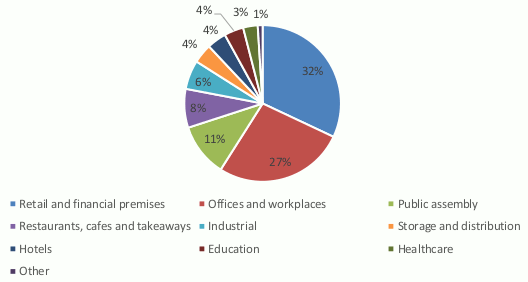
Although this data gives an insight into the amount of non-residential heat-controlled building stock in Scotland, data on the number of new non-residential buildings or those undergoing major renovation is limited.
Scottish House Condition Survey data indicates that up to 44% of households in Scotland might not have adequate access to off-street parking. Giving those households the confidence to switch to an EV will require a significant upscaling of EV charging opportunities in public, at work and/or at other convenient locations.
As highlighted above, Scottish House Condition Survey data indicates that up to 44% of households in Scotland might not have adequate access to off-street parking. To give those households the confidence to switch to an EV will require a significant upscaling of EV charging opportunities in public, at work and/or at other convenient locations.
We, therefore, consider that our policy option for new non-residential buildings and new non-residential buildings undergoing major renovation is proportionate but also reflective of the scale of action required to support a high volume uptake of EVs. Similar to residential buildings described above, published data also highlights the cost-benefit of installing ducting and EV charge point infrastructure where construction works are being undertaken. Table 17, for example, taken from the 2019 draft UK Government impact assessment, shows that the additional unit cost of retrospectively installing an EV charge point in comparison to installing at point of build could be significantly greater.
| Parking Type | Cost - New (Low) | Cost - New (High) | Cost - Retrofit (Low) | Cost - Retrofit (High) |
|---|---|---|---|---|
| EV Charge point | £1,182 | £6,463 | £1,640 | £8,210 |
7.5.8 Existing non-residential buildings
In keeping with the approach set out above, our preferred options for existing non-residential buildings seeks to require the installation of ducting infrastructure in 1 in every 2 parking spaces and for 1 in every 10 parking spaces to provide an EV charge point socket. A crucial difference to our approach for new non-residential and major renovations, however, is that we only intend to apply these requirements to existing non-residential buildings with more than 20 parking spaces. In line with the timescales set out in the Directive 2018/844, we intend the requirements for building owners to install ducting infrastructure and EV charge points to apply from 1 January 2025.
7.5.9 Enforcement of requirements for car parks of existing non-residential buildings
We are exploring options for enforcing the requirements associated with existing non-residential buildings as set out in section 7.5.8, given that the Building (Scotland) Regulations will not apply in this scenario. This might involve use of powers available through the UK Withdrawal from the European Union (Continuity) (Scotland) Act 2021 with enforcement being undertaken by a Scottish Public Authority, so long as such a function is broadly consistent with the general objects and purposes of the authority.
We are keen to gather feedback on how enforcement might be achieved particularly in terms of what body or bodies may be best placed to undertake this function. We are also keen to gather feedback on potential incentives and penalties and how these might be applied fairly, taking into account potential variation in the costs of infrastructure across different building car parks types and geographies.
7.6 Exemptions
7.6.1 Introduction
In addition to our option to apply an exemption to the requirement to install EV charge points in car parking spaces of new residential buildings, where the additional electricity grid connection cost for each EV charge point exceeds £2,000 (section 7.5.5), we have also considered the use of the exemptions inserted in 8 of Directive 2010/31/EU by Directive 2018/844. These exemptions along with the Scottish Government’s preferred options are summarised in Table 18.
Table 18. Summary of Scottish Government preferred options in relation to the application of exemptions from requirements.
Article 4
Exemption: Buildings owned and occupied by SMEs.
Scottish Government preferred option: No intention to apply.
Article 6(a)
Exemption: Building permit applications or equivalent applications have been submitted by 10 March 2021.
Scottish Government preferred option: Not applicable as date of exemption has passed.
Article 6(b)
Exemption: If ducting infrastructure required would rely on micro-isolated systems and if this would lead to substantial problems for local energy system operation and endangering grid stability.
Scottish Government preferred option: No intention to apply.
Article 6(c)
Exemption: Cost of recharging and ducting infrastructure exceeds 7% of total major renovation cost.
Scottish Government preferred option: Apply to both residential and non-residential buildings undergoing major renovations.
Article 6(d)
Exemption: A public building is already covered by comparable requirements according to transposition 2014/94/EU.
Scottish Government preferred option: No intention to apply.
7.6.2 Buildings owned and occupied by Small and Medium Enterprises
As of March 2019, there were an estimated 356,550 private sector businesses operating in Scotland of which the majority (99.3%) were Small and Medium enterprises (SMEs)[57].
We are not proposing to exempt SMEs from requirements associated with non-residential buildings. SMEs will realise both cost and convenience benefits of installing ducting infrastructure and EV charge points at the time of construction or during the major renovation of the building they own and occupy. We consider that the cost of provision is justifiable in proportion to the cost of the triggering building works, regardless of the organisation characteristics of the owner/developer.
We are also of the view that if SMEs own and occupy existing buildings with more than 20 car parking spaces, then car parks of this scale should be adequately equipped with EV charge points and/or the enabling infrastructure to facilitate convenient deployment of EV charging infrastructure in the future.
7.6.3 Micro-isolated systems
The Directive provides for an exemption where ducting infrastructure required would rely upon micro-isolated systems or the buildings are situated in the outermost regions within the meaning of Article 349 of the Treaty on the Functioning of the European Union, if this would lead to substantial problems for the operation of the local energy system and endanger the stability of the local grid.
Whilst no parts of Scotland fall within an ‘outermost region’, there are parts of Scotland that are not connected to the main GB electricity system, and which could have an annual energy consumption of less than 500 GWh and be classed as a micro-isolated system[58]. These might include for example: Canna, Eigg, Fair Isle, Foula, Knoydart, Muck, Rum and Shetland.
Our preferred option is not to seek to apply an exemption for buildings within micro-isolated systems as we want to ensure that everyone benefits from the transition to EVs and that no communities are left behind. We believe that it is unlikely that for areas of Scotland that might fall into the category of having a micro-isolated energy system that there would be buildings and car parking development of the scale that would endanger the stability of the local electricity grid. We are interested to hear further views on this.
7.6.4 Cost of ducting and EV charge points in major renovations
The Directive provides an exemption where the cost of installing EV charge points and ducting infrastructure exceeds 7% of the total cost of the renovation. This threshold is based upon the minimum requirements for ducting and EV charge points that the Directive sets out for residential and non-residential buildings undergoing major renovation.
We are sensitive to the cost impact that requirements for installing EV infrastructure may have on the financial viability of a building’s major renovation. Equally, however, we see the opportunities and benefits of installing EV charge points whilst this work takes place.
Our intention would be to apply a 7% exemption, in terms of the cost of ducting and EV charge point infrastructure, both for residential and non-residential buildings undergoing major renovation. Where this exemption applies, we would expect infrastructure to be installed up to the point that it can be accommodated with the overall 7% cost threshold. We welcome views on this or an alternative approach.
7.6.5 Public buildings already covered by comparable requirements
There are no comparable requirements currently in place for public buildings other than those which may have been imposed as a result of conditions of planning. Therefore, we do not intend to exempt public buildings from the requirements that we aim to establish.
7.7 Other Considerations
7.7.1 Accessibility
Scottish Planning Policy provides minimum provision standards for new developments in relation to accessible parking[59]. For retail, recreation and leisure developments the minimum provision should be:
- 3 spaces or 6% (whichever is greater) in car parks with up to 200 spaces; or
- 4 spaces plus 4% in car parks with more than 200 spaces.
Employers also have a duty to consider the disabilities of their employees and visitors to their premises. The minimum number of accessible parking spaces at places of employment should be:
- 1 space per disabled employee plus 2 spaces or 5% whichever is greater in car parks with up to 200 spaces; or
- 6 spaces plus 2% in car parks with more than 200 spaces
Scottish building regulations do not require car parking at new developments but, where parking is provided, seek provision of accessible parking spaces and associated means of access. For parking to blocks of flats[60] and non-domestic buildings[61], accessible spaces should be provided at a ratio of 1:20 or part thereof.
Therefore, to ensure that those using accessible parking spaces have sufficient access to charge point sockets, we are considering proposing that at least 1 accessible parking space should have access to an EV charge point socket for every 4 accessible parking spaces. If a car park has less than 4 accessible parking spaces then at least one of those spaces should have access to an EV charge point socket. These requirements would be additional to those laid out in section 7.5.3.
7.7.2 Safety within the Built Environment
As EVs are a relatively new and an evolving technology, increasing our understanding of their safety within the built environment is important. For example, given the different fuel/power sources between EVs and petrol/diesel vehicles, do EVs, and the accompanying infrastructure, carry specific risks that may require different measures to be considered in the safety design of buildings (additional fire prevention measures for example).
We are building up our understanding and evidence-base to inform our overall approach. Therefore we welcome responses that also address any potential safety issues.
7.8 EV consultation questions
Question 51 –
What are your views on our policy goal to enable the installation of Electric Vehicle (EV) charge points and ducting infrastructure (to facilitate the future installation of EV charge points) for parking spaces in new residential and non-residential buildings parking?
Question 52 –
What are your views on our preferred options for:
New residential buildings
All dwellings with a parking space to have at least one EV charge point socket with minimum 7kW output power rating.
Exemption to requirement to install EV charge point if additional cost of electricity grid connection exceeds £2,000.
If exemption applies ducting infrastructure to be installed in each car parking space.
Residential buildings undergoing major renovation
For buildings with more than 10 car parking spaces, ducting to be installed in each residential car parking space to support the future installation of an EV charge point.
EV charge points sockets to be installed, with minimum 7kW output power rating, in as many residential car parking spaces as the electrical capacity of the building post-renovation allows.
Exemption applies if the cost of installing recharging and ducting infrastructure exceeds 7% of total major renovation cost.
New non-residential buildings
For buildings with more than 10 non-residential car parking spaces, 1 in every 2 non-residential parking spaces to have ducting installed and 1 in every 10 non-residential parking spaces to provide an EV charge point socket with minimum 7kW output power rating.
Non-residential buildings undergoing major renovation
For buildings with more than 10 non-residential car parking spaces, 1 in every 2 non-residential parking spaces to have ducting installed and 1 in every 10 non-residential parking spaces to provide an EV charge point socket with minimum 7kW output power rating.
Exemption applies if the cost of installing recharging and ducting infrastructure exceeds 7% of total major renovation cost.
Existing non-residential buildings
By 1 January 2025, for buildings with more than 20 non-residential car parking spaces, 1 in every 2 non-residential parking space to have ducting installed and 1 in every 10 non-residential parking space to provide an EV charge point socket with minimum 7kW output power rating.
Question 53 –
Do you agree with the Scottish Governments preferred options for the exemptions as set out in section 7.6.1?
Exemption: Buildings owned and occupied by SMEs.
No intention to apply.
Exemption: If ducting infrastructure required would rely on micro-isolated systems and if this would lead to substantial problems for local energy system operation and endangering grid stability.
No intention to apply.
Exemption: Cost of recharging and ducting infrastructure exceeds 7% of total major renovation cost.
Apply to both residential and non-residential buildings undergoing major renovations.
Exemption: A public building is already covered by comparable requirements according to transposition 2014/94/EU.
No intention to apply.
If you disagree, please explain why?
Question 54 –
What are your views on how our preferred option relating to existing non-residential buildings with car parks with more than 20 spaces could be properly monitored and enforced, given that the Building (Scotland) Regulations will not apply?
Question 55 –
What are your views on the proposed provision for charge points for accessible parking spaces? Do you have examples of current best practice for the provision of charge points for accessible parking spaces?
Question 56 –
Do you have any other views that you wish to provide on the EV section of the consultation (e.g. the minimum standard of EV charge point or safety within the built environment)?
7.9 Flow charts of policy proposals.
7.9.1 New Residential Buildings
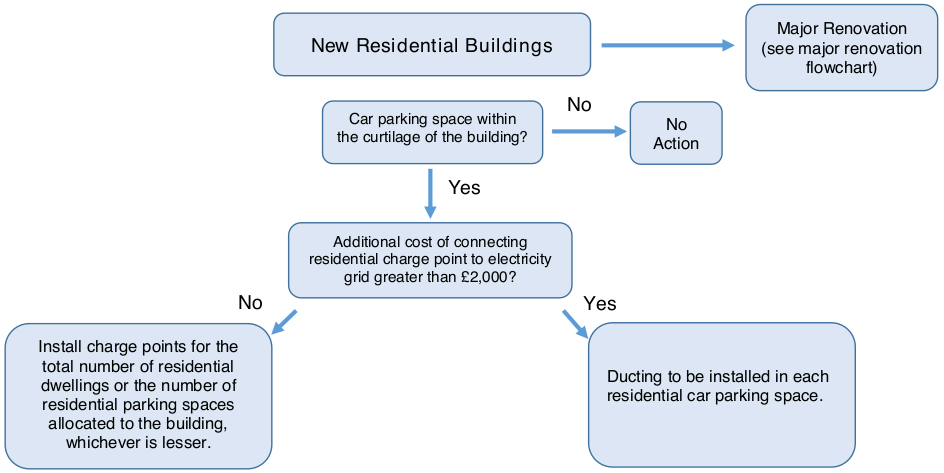
7.9.2 Residential Buildings (major renovation)
7.9.1 New Residential Buildings
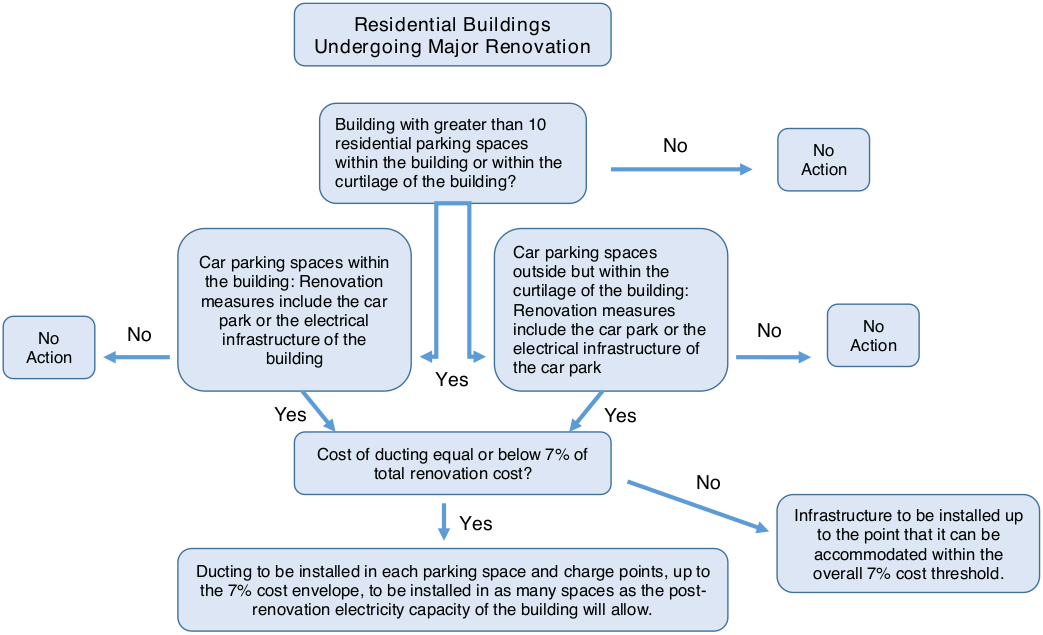
7.9.3 New Non-Residential Buildings
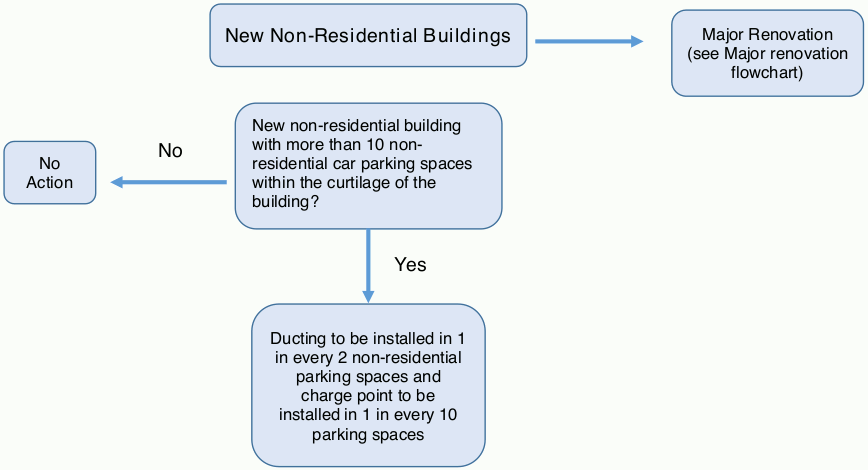
7.9.4 Non-Residential Buildings (major renovation)
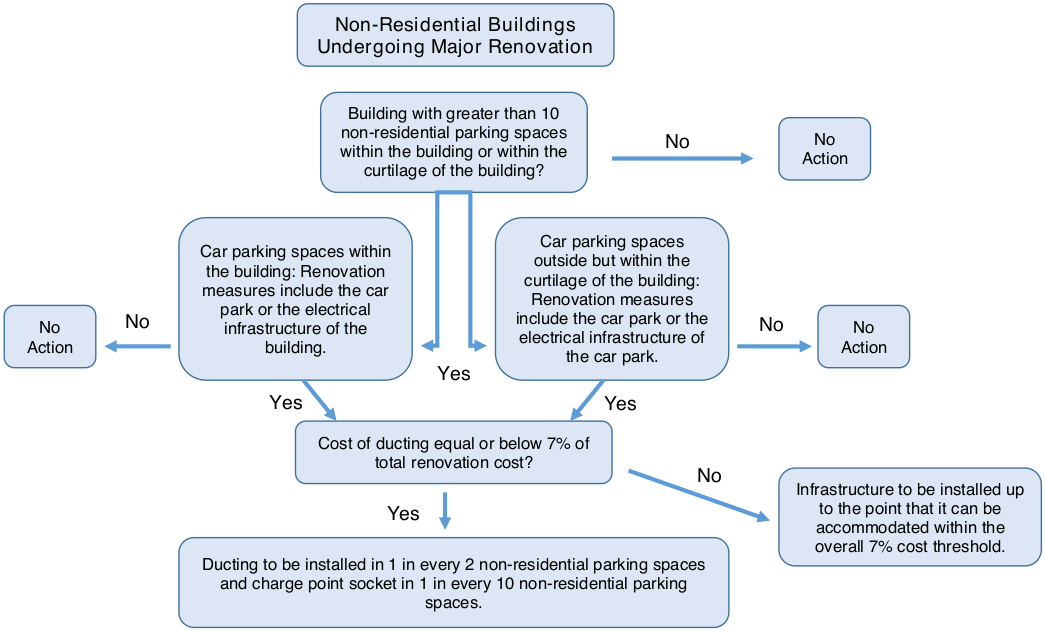
7.9.5 Existing Non-Residential Buildings
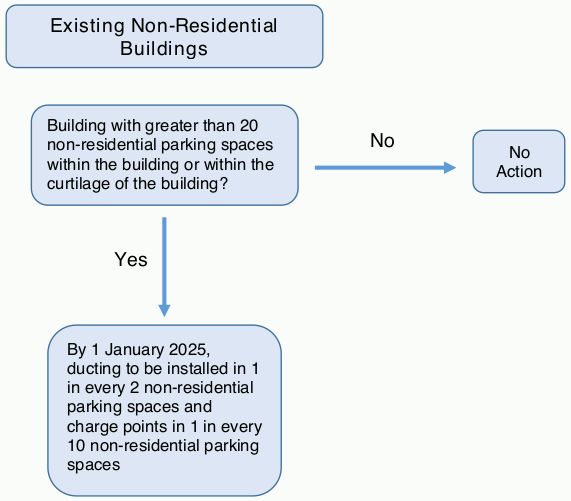
Contact
Email: buildingstandards@gov.scot
There is a problem
Thanks for your feedback